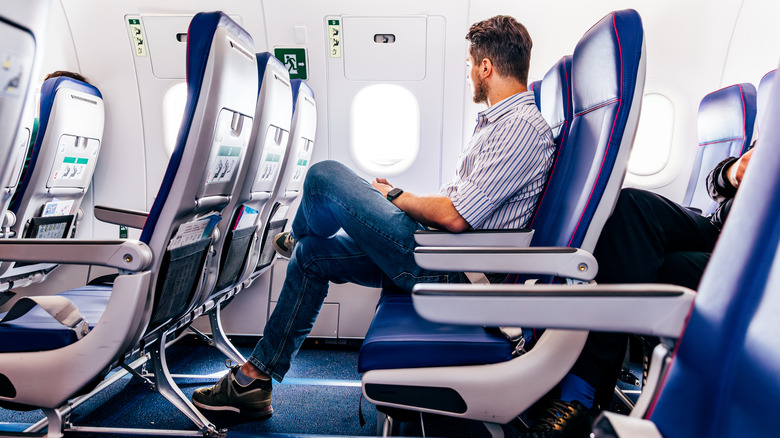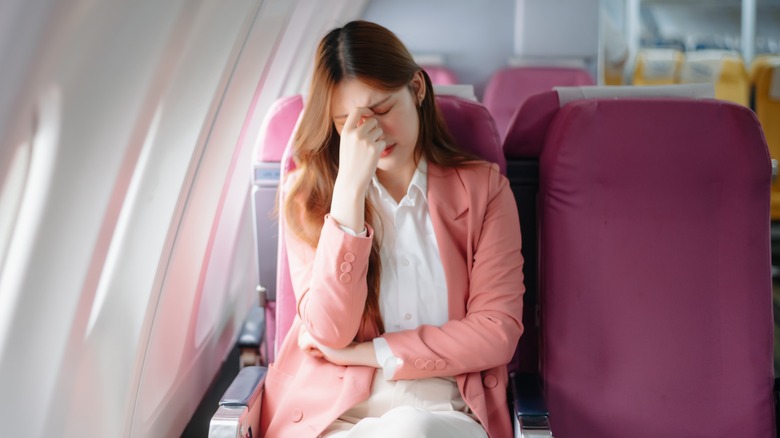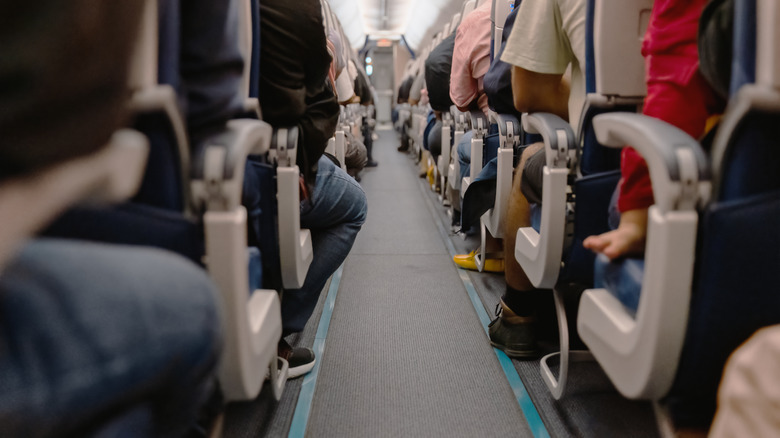Here's Why You Should Avoid Using A Foot Hammock On Your Next Flight
Plane seats are notoriously uncomfortable, and sitting in the same position for hours can lead to back pain, numb feet, and even blood clots. An easy hack to make your economy flight a little more comfortable is resting your feet in a foot hammock. The contraption is exactly what it sounds like: A fabric device that attaches to the seat in front of you, creating a sling for your feet to keep them elevated. The hammocks can be purchased from a store or DIYed with a scarf, as TikToker @wandering__around demonstrated in a viral video. There are also inflatable footrests, which offer benefits similar to those of the hammocks.
While the idea of a foot hammock or inflatable footrest might seem brilliant, you should think twice before buying one for your next flight. Some air carriers have started banning foot hammocks and other types of footrests in passenger cabins. A representative for United Airlines wrote in a post on X (formerly known as Twitter) that footrests are considered "an alteration to the seat" and are therefore prohibited. Other airlines that have formally banned the devices include Qantas, Emirates, and British Airways. And even if you're flying on an airline where they aren't explicitly banned, it's probably still best to avoid using one due to safety and courtesy concerns.
Footrests can cause problems for other passengers
Propping your feet up on a plane might seem innocent enough, but one reason airlines are barring foot hammocks and footrests on flights is that they can be hazardous in some situations. Just as your carry-on items must fit under the seat in front of you, footrest devices must also be easy to stow away in case of an emergency. A bulky inflatable footrest or tied-up hammock could block or trip other passengers during an evacuation. Even if emergencies are rare, some airlines have decided it's not worth the risk.
Another reason foot hammocks and similar items might be best left at home is that they can disrupt the person seated in front of you. Footrests that hang from the seat can jostle your neighbor whenever you shift your feet or legs. This is annoying at the best of times but can be particularly irritating during long flights when the person in front of you is trying to get some shuteye.
Inflatable footrests aren't much better. Depending on the size and model, these devices can prevent the person in front of you from reclining their seat. If you have strong opinions on airplane seat reclining etiquette, this might seem like a total win. However, it likely won't earn you any friends on the plane, and the flight attendant may order you to stash the item away to make room.
Better ways to stay comfortable on a flight
If your airline doesn't allow footrests, or if you've determined they're not worth the trouble, there are still a few hacks for staying comfortable on your flight. To elevate your feet and legs, swap a footrest for a carry-on bag or backpack. Just slip the bag out a little from under the seat in front of you, stuff it with a blanket or other items if needed, and prop your feet up for a little relief. If another passenger needs to get by, simply push it back under the seat to clear the path.
If you start to feel stiff in your seat or your feet become numb or tingly, try moving around to stretch your muscles and promote circulation. Walking up and down the aisles every hour or so can bring feeling back to your limbs, and a quick stretch in the space near the galley can work out any tension. Just be sure to obey the seatbelt sign and stay seated when required.
Finally, while it isn't the cheapest strategy, upgrading your seat could be the key to a more comfortable flight. Some premium economy seats come with built-in airline-approved footrests and don't usually cost much more than standard economy seats. For maximum foot elevation, a business or first class seat can be an even better (though pricier) option.


